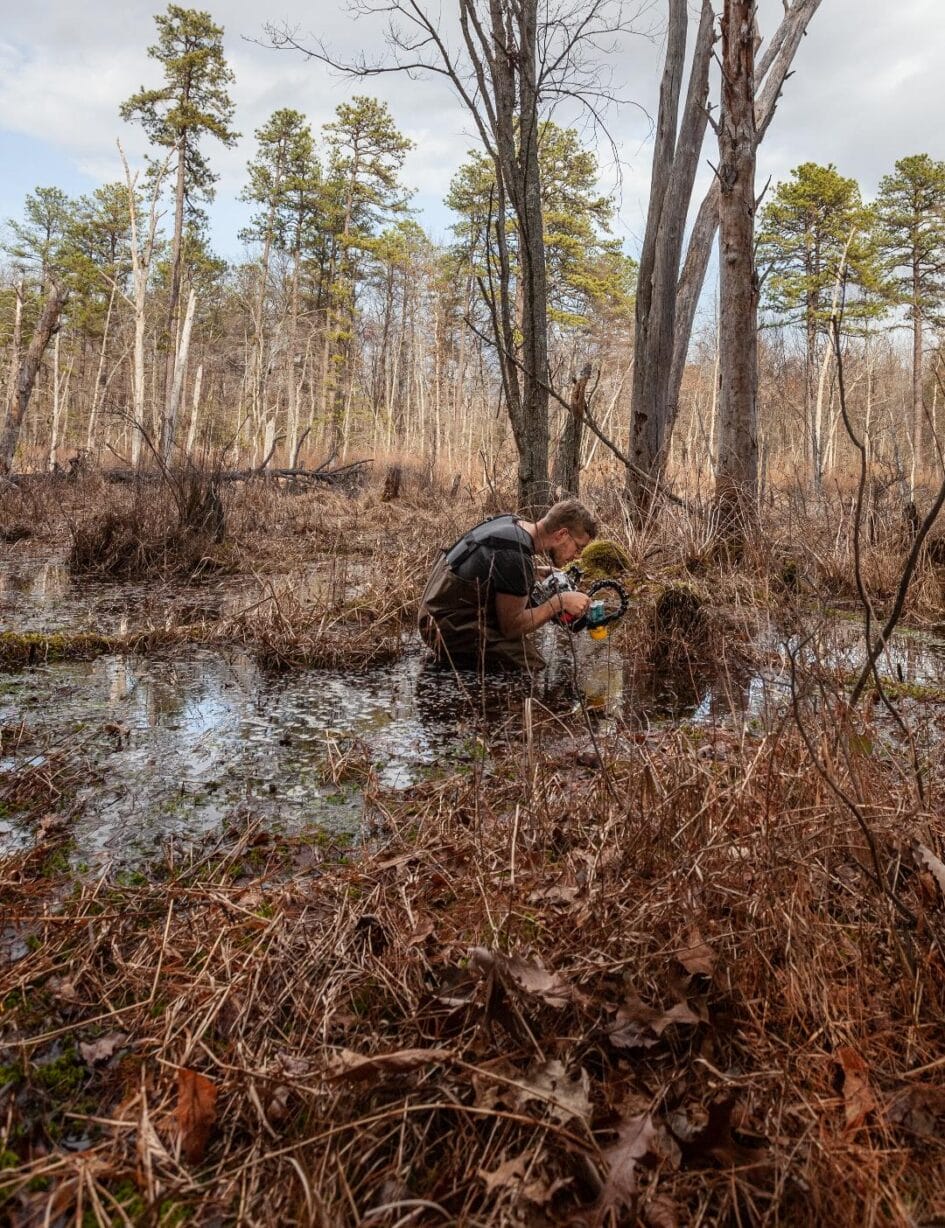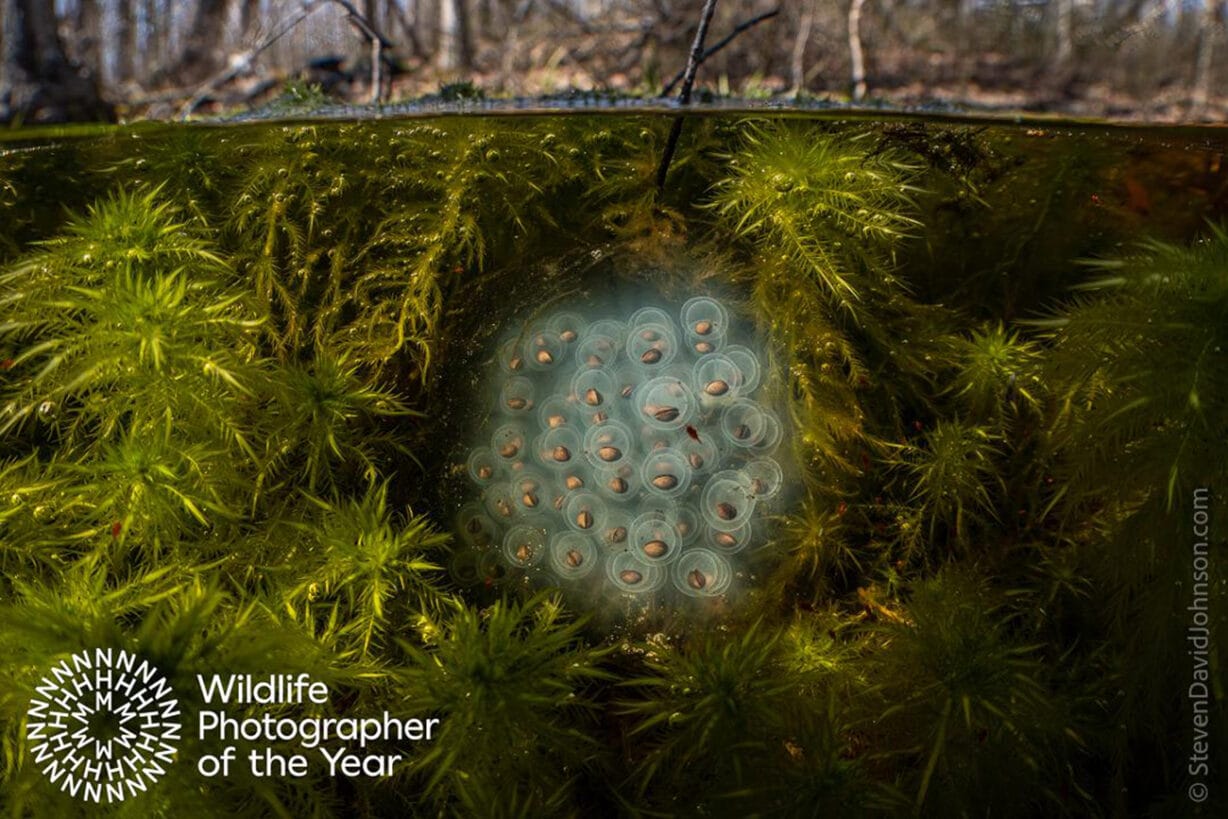
By Stephanie Spernak, contributor
Steven David Johnson, an award-winning conservation photographer, specializes in underwater close-ups of tiny creatures that inhabit freshwater pools found in forested areas in Virginia — including some species found only in this region.
Johnson is presenting a multimedia show of his work at 7 p.m. in the main meeting room of the Massanutten Regional Library in Harrisonburg. His talk will reflect a natural history approach that photographs animals in their natural environments. He said that photography’s method of direct observation can “advance advocacy work and deepen understanding of natural history.”
“A lot of what drives me,” Johnson said, “is actually the natural history aspect. I love learning more about the ‘more-than-human’ world.”
His wildlife photography has been featured in conservation publications, including Nature Conservancy Magazine, Orion, Ranger Rick, Virginia Wildlife and in books published by the National Science Teachers Association Press. In addition to teaching at Eastern Mennonite University, he serves as the vice-president of the Virginia Wilderness Committee.
In an interview with the Citizen, Johnson said that he considers conservation photography to be a way of “using nature photography to advocate for the protection of the natural world.”
“As an artist, the formal aesthetics are an important part of communication. And ultimately, the advocacy works closes the communication loop,” he said.

Creating the award-winning “Pool of Wonder”
Johnson’s image, “Pool of Wonder,” won recognition as one of the top 100 Wildlife Photographs of the Year in 2023 bythe Natural History Museum in London, an award considered one of the most prestigious in the field of wildlife photography.
Johnson’s photograph was selected from among almost 50,000 entries submitted by wildlife photographers across the globe. The caption described his entry as showing a “clump of spotted salamander eggs resting on a bed of sphagnum moss in a vernal pool” located near the Shenandoah National Park.” Johnson said he intended the image to convey the vital importance of vernal pools for conservation efforts.
Vernal pools, also called ephemeral pools or ponds, are seasonal. They typically fill with rainwater and snow melt during the spring, the “vernal” time of year. These pools later dry out, repeating this cycle in subsequent years.
Johnson’s “Pool of Wonder” went on to be one of the 13 wildlife photos the National Geographic Society in Washington, D.C. selected with conservation themes from among the Museum’s 100 winning entries.

Revealing hidden life in vernal pools
Only certain species of amphibians such as salamanders and frogs, and some crustaceans known as fairy shrimp, have adapted to life in these seasonal pools of water. Fish, for example, cannot survive in them. Fish can only live in permanent aquatic habitats, a situation that works out well for the egg-laying amphibians, which then can avoid egg-eating predators like certain fish.
When Johnson arrived in Harrisonburg to start his teaching job at EMU, he said he soon learned “Central and Southern Appalachia are biodiversity hotspots — particularly for salamanders.”
“Rare endemic species like the Cow Knob Salamander live on the Shenandoah Mountain crest and nowhere else in the world,” he said. “That said, our wildlife is under a great deal of stress from development, climate change, agricultural runoff, and other threats.”
In late winter and early spring, the pools are the sites of breeding events for amphibians and macroinvertebrates.
“As a conservation photographer, I’m drawn to the intricate dance of underwater life in Appalachian Mountain forests and nearby lowlands,” he said.
He decided to concentrate his conservation photography work on creating underwater images that reveal the hidden life in vernal pools to raise public awareness about these special habitats and help protect them from destruction.
He said his photos of the Cow Knob salamanders “were used by advocates in the fight against the Atlantic Coast Pipeline.” It was a controversial 600 mile natural gas pipeline that would have run from West Virginia, through Virginia and end in eastern North Carolina. The pipeline project was cancelled in July 2020.
Johnson and two colleagues created a free digital handbook called “Vernal Pools – Documenting Life in Temporary Ponds,” which the North American Nature Photography Association also makes available to provide information and advice for other photographers interested in vernal pool habitats.
Johnson, who worked on the book while on a sabbatical from EMU, described the 70-page handbook as containing images and observations from nearly a decade of his work, as well as photographic salamander behavior studies by Dave Huth, and essays on geology and conservation by vernal pools expert, Michael S. Hayslett.
Hayslett, the founder of Virginia Vernal Pools, said Johnson’s “intimate underwater photographs” have made Johnson a “leading documenter of vernal pools, seeking to spread the word about conserving these special places.”

“Hidden dragons” and exploring their habitats
Johnson then turned to filming two short videos with conservation filmmaker Alex Wiles that feature the behaviors of salamanders in vernal pools.
He said that he became fascinated with salamanders — or “hidden dragons,” as some folks call them — as he learned more about them.
Johnson said he is now expanding his conservation photography beyond vernal pools to riverine habitats, which include the river channel, the banks of the river (called riparian zones), and the river’s surrounding floodplain, where wetlands with vernal pools can form.
Riverian habitats is a work in progress, he said, and will be series of photos and videos to be called “Riverine — Exploring Biodiversity on the Shenandoah River.” An exhibition of this work was recently shown at Bridgewater College.
Getting an early start
Johnson said he has always been interested in art and the natural world. He grew up in Allegheny County, New York, which he described as “much more rural than here.”
He started drawing at 3 and learned conventional photography during high school and then majored in Art as an undergraduate at Houghton College in New York. He went on to graduate school and earned his M.F.A. in what at that time was called computer art at the Savannah College of Art and Design.
In 2005, he accepted a faculty position at EMU and he and his wife moved to a farmhouse in Cootes Store, a village outside of Broadway, close to the North Fork of the Shenandoah River. He said he loves to photograph wildlife in the riverine ecosystems on the North Fork of the Shenandoah River underwater or from his kayak.
For those who would like to get into conservation activities and photography, Johnson said they should start with a “passion project” close to home. He recommended joining local non-profits like Wild Virginia, Friends of Shenandoah Mountain, and Virginia Wilderness Committee that host field excursions.
“There is so much to learn by observing local natural history,” Johnson said.
Thanks for reading The Citizen, which won the Virginia Press Association’s 2022 News Sweepstakes award as the top online news site in Virginia. We’re independent. We’re local. We pay our contributors, and the money you give goes directly to the reporting. No overhead. No printing costs. Just facts, stories and context. We value your support.












